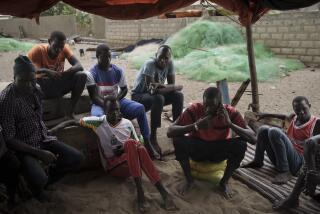Narrative of a Voyage to Senegal by J. B. Henry Savigny and Alexander Correard (Marlboro: $11.50; 200 pp., paperback)
- Share via
Apainting by Jean Louis Gericault has kept a horror story alive for close to 200 years. Now the editors of Marlboro Books have published a written narration of the event, as told by two survivors. Their account releases Gericault from any lingering suspicions that his “Raft of the Medusa” suffers from emotional indulgence.
It is a memoir of mutiny, murder, cannibalism, suicide and starvation that turns all the more chilling as told by its cool-headed narrators, the surgeon J. B. Henry Savigny and the naval officer Alexander Correard. French loyalists and pragmatists, they claimed their only reason for reporting the disaster was to set the record straight.
Gericault’s painting now stands as an art-historical landmark where classic and romantic styles clashed, and the co-authored book is a landmark as well. It dramatizes a heroic struggle between humane and inhuman urges acted out by 150 victims of a shipwrecked frigate.
The book was first published in September, 1816, three months after the French governor-designate of Senegal, identified by the authors as Schmalz (a misspelling of his name, Chemals) and 243 passengers set sail for the French colony. Their frigate, the Medusa, went aground off the coast of Mauritania, west of their destination. The authors drew on their own and others’ experiences in their reconstruction of the disaster that followed.
They describe a flimsy raft put together by members of the crew and passengers from pieces of the larger frigate lashed together with rope. The authors remark that those assigned to the raft were the most frail or least socially significant people on board the ship. The others, including the governor and his family, the ship’s captain and crew, and the most able-bodied passengers took to the Medusa’s five lifeboats. Everyone set out for Senegal’s northern port of Saint Louis together. But the seaworthy lifeboats pulled ahead and quickly disappeared from view. For 13 days, the authors’ raft baked in tropical sun. At night, high winds sent mountains of water breaking across the “fatal machine.” The weakest on board were dragged off by the sea. Mutineers stabbed others to death. In the morning, everyone ate the flesh of those they found dead. And when they were thirsty, they drank each other’s urine instead of sea water.
For all its grisly elements, this nightmare trip is told without drama. Neither author has an ear for language nor a gift for the narrative form. But their abilities as reporters of broad facts as well as intimate details give this gruesome story its compelling energy.
The authors write that justice is not served once the 15 men who survive are rescued by a brig sent out to find them. Noble Correard, who became the captain of the raft, was promised promotions and medals of honor by Chemals, but these promises were not kept. The governor did, however, bestow the Legion of Honor on a merchant he sent out to rescue the ship’s supplies. Rather than make amends or even apologize for abandoning them, Chemals ordered Correard and Savigny to retract their story and exonerate his name when their report was published in France and England. The authors refused.
There is no happy ending here. Both Correard and Savigny died in France--frail, forgotten men. Chemals lived on as governor of a rich African trade port, in an elegant French Colonial mansion.
This book represents one form of justice. It gives the power of the last word to those who deserve it.
More to Read
Sign up for our Book Club newsletter
Get the latest news, events and more from the Los Angeles Times Book Club, and help us get L.A. reading and talking.
You may occasionally receive promotional content from the Los Angeles Times.










